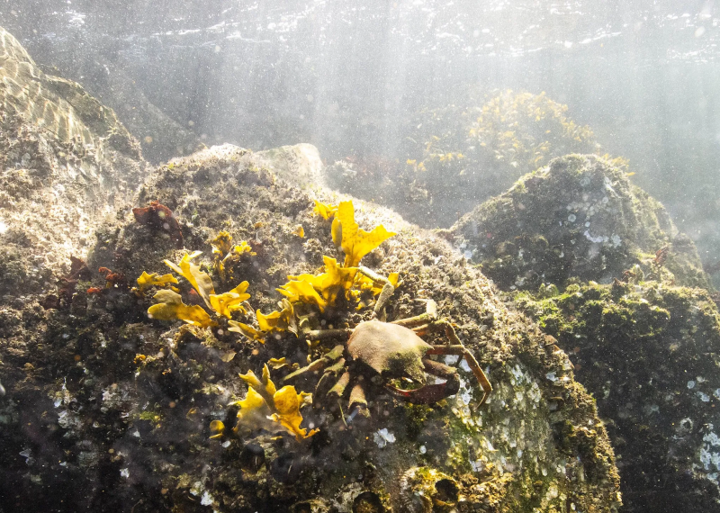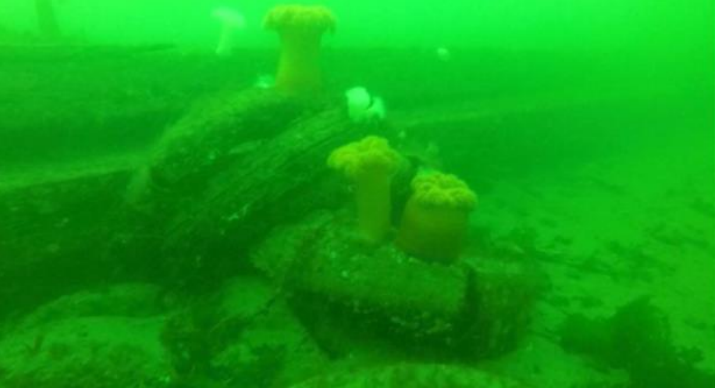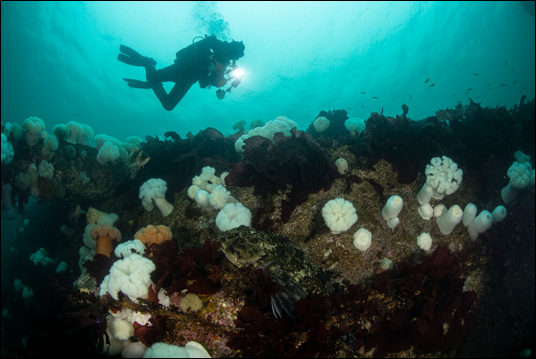Artificial Reefs to the Rescue: Puget Sound’s Success Stories and Lessons Learned
Naturally occurring reefs are found below the surface waters of Puget Sound. Although they might not resemble the quintessential colorful coral gardens found in the tropics, below the Salish Sea’s surface are submerged rock outcrops with complex crevices and alcoves that create suitable habitats for many forms of life. Algae and invertebrates such as anemones colonize the surface area of these rocks. Juvenile and smaller fish species are attracted by the complex structures and use these temperate reefs as refuge from currents and predators. Each rocky reef is unique, with different communities of marine species calling it home.
Puget Sound reefs serve Washington communities on land by buffering our shores from wave energy, storms, and coastal erosion, effectively slowing down and diverting water movement below the surface. For generations, fishers have known that reef structures are great fishing locations because they form biodiversity hotspots. Lingcod, yelloweye rockfish, and copper rockfish are just a few of the species that prefer rocky reef habitats and are sought after by fishers for subsistence, recreational, and commercial fishing in the Puget Sound. Half of Puget Sound’s Marine Protected Areas (MPAs) contain rocky reef habitats that are home to Endangered Species Act-listed rockfish species. Amid Washington state’s MPA sites are two successful artificial reefs that were installed to support flourishing marine communities.

Artificial reefs are submerged structures that have been deliberately placed on the seabed to mimic the characteristics of natural reef habitats. Artificial reefs have been implemented around the world for a variety of coastal and ecosystem management strategies . Some countries use artificial reefs as a restoration strategy where natural reefs have been disrupted by coastal development, trawling, and habitat degradation. Often, they are designed and installed with the intention of providing supplementary habitat for marine species by adding structural complexity with their vertical relief and rugosity, or structural complexity. Artificial reef structures and crevices tend to attract marine communities that seek food sources, shelter, and breeding areas.
Lessons Learned
A variety of materials have been used for artificial reef construction in Puget Sound, with varying levels of success. In the 1970s-80s, new federal laws and court rulings meant salmon fishing limits were tightening for sport fishing enthusiasts who, in turn, pivoted to bottom-fishing opportunities for rockfish and lingcod. This sparked a large effort to increase recreational bottom-fishing opportunities, led by groups of recreational sport fishers and the Washington Department of Fish and Wildlife (WDFW). Amongst the materials used in artificial reef construction were concrete, natural rocks, vehicle tires, plastics, PVC, vessels, barges, train cars, etc. After decades on the seabed of Puget Sound, environmental and fisheries experts have observed a range of ecological impacts—both positive and negative—depending on the materials used, the planning involved, and the level of ongoing management provided for these artificial reefs.
The most infamous project-turned-lesson was the installation of 20 artificial reef sites composed of thousands of used vehicle tires, bundled together with polypropylene rope during the 1970s. Decades later, the Washington Department of Natural Resources (DNR), the Washington Department of Ecology, and the Washington SCUBA Alliance (WSA) are organizing efforts to remove these tire reefs. The tires have eroded over time, fragmenting into smaller pieces, and increasing the amount of toxins leaching into the water. Formaldehyde and petroleum-based chemicals are released daily from these weathered tires. Further, studies connect the toxic compound 6PPD-quinone released from tires to Coho and Chinook salmon mortality events in streams with high surface water runoff from roads. These two migratory species already suffer from impaired water quality in their freshwater spawning grounds and the Salish Sea alike. Additional exposures to toxins from ineffective tire-reefs only exacerbate impaired water quality and biological stressors faced by salmon populations.

Tire material provides unsuitable habitat for marine life. Barnacles and mussels are unsuccessful in recruiting, or attaching, themselves to tire surfaces. In most observations, only a “lush growth of algae” is capable of covering the tires. Further, a lack of mussels, barnacles, and other prey sources for reef fish have been correlated with a scarcity of higher trophic level fish compared to other neighboring habitats. These tire reefs were implemented to add structural complexity to the seabed, yet have proven to be unsuitable habitats. It’s imperative to continue the coordinated efforts between the WA DNR, skilled diving groups, and waste disposal managers to remove old decomposing tires from our waters.
Success and Stewardship
Durable foundation materials and ongoing stewardship are the secrets to success for selected artificial reefs in Puget Sound. On the west side of Blake Island, an artificial reef installed by the WDFW is located approximately 40 to 80 feet below the surface and is composed of recycled concrete building materials. The entanglement of materials provides shelter for a multitude of marine species, including Quillback, Copper, and Brown Rockfish, Lingcod, small Sculpin, Painted Greenlings, and schools of Striped Seaperch and Pile Perch.
Edmonds Underwater Park is another thriving artificial reef ecosystem. Designated as a no-take zone since 1970 by the WDFW, this park consists of a 27-acre MPA with reefs composed of sunken boats and barges that are flourishing with vibrant marine life. The park itself has been stewarded by Bruce Higgins and a group of fellow divers since 1991 who value safety, security, and maintenance for park visitors. The Bruce Higgins Underwater Trail system stretches for 2.5 miles and is essentially a guided underwater playground for divers. Park stewards maintain new developments, invasive species removal, and ecosystem surveys, as well as buoys and signage to host more than 25,000 scuba divers annually. Every level of the food web seems to be thriving in this protected and stewarded artificial reef habitat. Eelgrass beds surrounding the sunken boats and barges provide a nursery for juvenile fish and crabs. Giant plumose anemones are neighbors to mussels, barnacles, shrimp, and many other invertebrates. The reef habitat also attracts giant lingcod, which can be viewed at “cleaning stations”, lazily waiting with their mouths open for symbiotic fish and shrimp to clean the parasites and build-up from their gills.

The WSA is a non-profit organization committed to the stewardship of sustainable marine environments. They have been involved in multiple clean-up efforts, including the Les Davis Tire Reef Removal near Tacoma, WA where over 2,000 tires were removed from the site. In addition to removing ineffective artificial reefs, they have installed and stewarded new reefs that provide habitat for marine life. Saltwater State Park in Des Moines, WA has been designated an MPA since 2009 thanks to the WSA. After years of working with state agencies to secure funding and permits, WSA installed an artificial reef composed of large granite boulders and concrete pilings which was designated as a no-take zone. Years later, it is a biodiverse habitat that octopus, lingcod, and many species of fish call home. Annual Young of the Year Rockfish monitoring is conducted here, contributing data to NOAA’s National Marine Fisheries Service recovery plan for ESA-listed bocaccio and yelloweye rockfish species.
Future of Artificial Reefs
When implementing future artificial reefs, careful planning of their materials, location, and ongoing monitoring is crucial. Natural resource managers should always consider the long-term impacts and sustainability of altering habitats. Artificial reefs have a complex history in Puget Sound, with both successes and challenges shaping their role in the marine ecosystem. The best artificial reefs add structure to the seafloor to enhance benthic habitats for marine species, including fishery favorites such as grouper and rockfish. Historically less effective artificial reefs have taught us crucial lessons regarding the selection of non-toxic and durable materials for foundational habitat structures.
There is interest in coastal areas globally to use artificial reefs for coastal protection, recreational fishing, and environmental restoration. Hundreds of artificial reef projects worldwide were reviewed, and it was found that concrete, along with natural stone and rock, are by far the most favored artificial reef construction materials. This is great news for project planners—scrap concrete from demolished bridges and buildings is typically cheap to source and offers opportunities to repurpose old materials. Quarry rock and scrap concrete both add substantial rugosity to the seabed and bear some resemblance to naturally occurring rocky reefs. These simple materials are resilient to erosion and introduce minimal contaminants to the underwater ecosystem compared to alternatives. Further, innovative strategies and materials are improving upon the effectiveness of artificial reefs around the world. In Australia, scientists incorporated recycled oyster shells and sea sand into a concrete mix. They found that adding shells and sand both improved sustainability in the supply chain of creating the concrete as well as were preferred for shellfish larvae to attach to the reef. Creative designs such as this will lead the way into a future of implementing nature-based coastal protection and sustainable fisheries management solutions.
Artificial reefs could play a crucial role in habitat restoration efforts as well as the future of sustainable ecosystem-based fisheries management. Funding for artificial reefs could be sourced from fishing licenses, with portions of reef zones open to fishers. Here in our Puget Sound, stewardship groups maintain artificial reefs for recreational fishing and SCUBA diving opportunities. Some artificial reef sites provide additional benefits to neighboring habitats by forming eddies that shield from strong currents and promote eelgrass recruitment. The WA DNR will consider artificial reef proposals that fill habitat needs and are designed to improve and enhance species diversity in the larger network of MPAs. In Puget Sound, artificial reefs have the potential to support benthic marine community structures, recreational fishing, eelgrass restoration, and shoreline protection.
The following sources were used that may be behind a paywall, please contact the Currents Editor-in-Chief for access.
[1] Baine, M. (2001) Artificial reefs: a review of their design, application, management and performance. Ocean & Coastal Management, 44(3-4), 241-259.
[2] Relini G. (2000) The Loano artificial reef. In: Jensen AC, Collins KJ, Lockwood APM, editors. Artificial reefs in European seas. Dordrecht: Kluwer Academic Publishers, 2000. p. 129–50.
[3] Williams, G. D., Levin, P. S., & Palsson, W. A. (2010) Rockfish in Puget Sound: An ecological history of exploitation. Marine Policy, 34(5), 1010-1020.
[4] Aleksandrov B. G. Minicheva, G.G. Srikalenko, T.V. (2002) Ecological Aspects of Artificial Reef Construction Using Scrap Tires. Russian Journal of Marine Biology. Vol. 28 (2). Pp. 120-126.
[5] Tian, Z., Zhao, H., Peter, K. T., Gonzalez, M., Wetzel, J., Wu, C., Hu, X., Prat, J., Mudrock, E., Hettinger, R., Cortina, A. E., Biswas, R. G., Kock, F. V. C., Soong, R., Jenne, A., Du, B., Hou, F., He, H., Lundeen, R. Kolodziej, E. P. (2021) A ubiquitous tire rubber– derived chemical induces acute mortality in coho salmon. Science, 371(6525), 185– 189.
[6] Rupasinghe, M., San Nicolas, R., Lanham, B. S., & Morris, R. L. (2024). Sustainable oyster shell incorporated artificial reef concrete for living shorelines. Construction and Building Materials, 410, 134217.